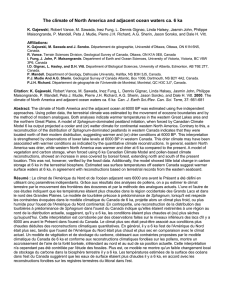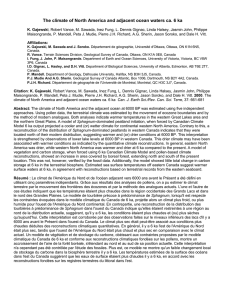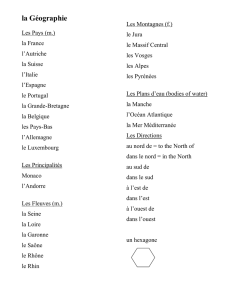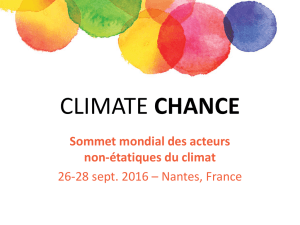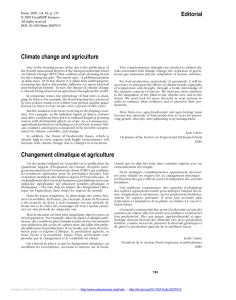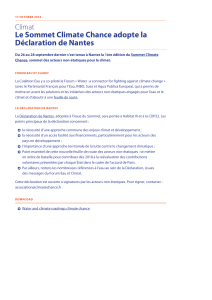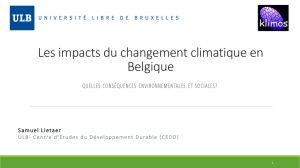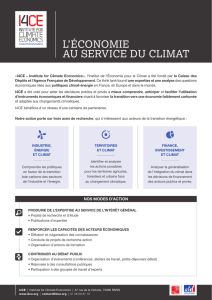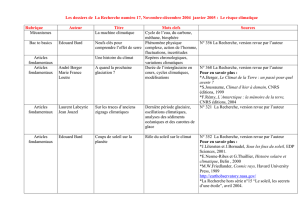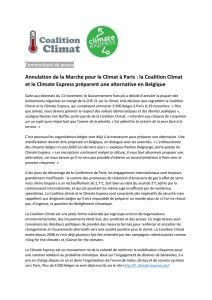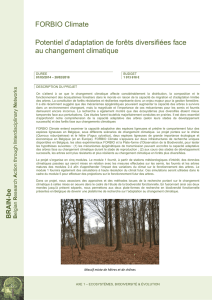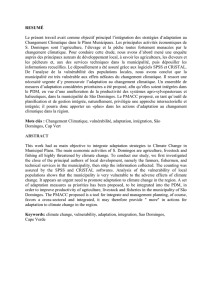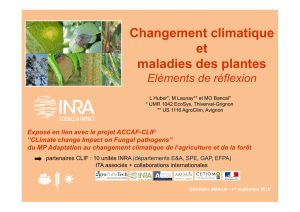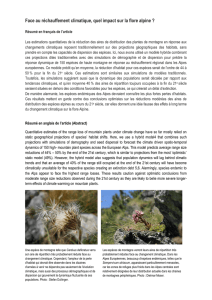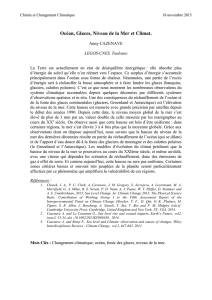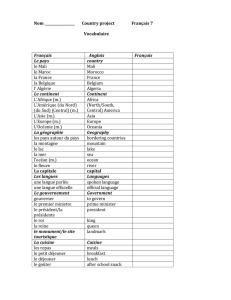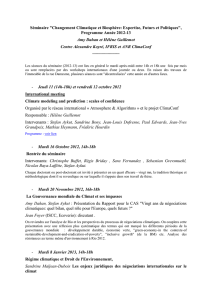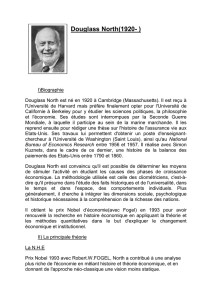The climate of North America and adjacent ocean waters ca. 6 ka
publicité
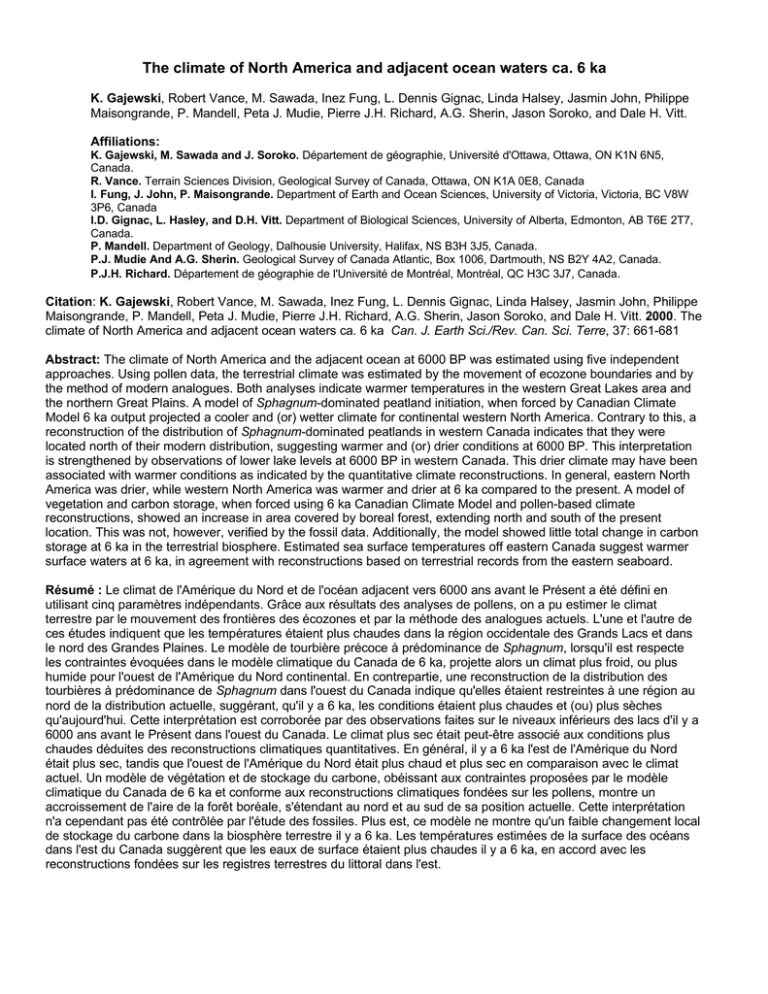
The climate of North America and adjacent ocean waters ca. 6 ka K. Gajewski, Robert Vance, M. Sawada, Inez Fung, L. Dennis Gignac, Linda Halsey, Jasmin John, Philippe Maisongrande, P. Mandell, Peta J. Mudie, Pierre J.H. Richard, A.G. Sherin, Jason Soroko, and Dale H. Vitt. Affiliations: K. Gajewski, M. Sawada and J. Soroko. Département de géographie, Université d'Ottawa, Ottawa, ON K1N 6N5, Canada. R. Vance. Terrain Sciences Division, Geological Survey of Canada, Ottawa, ON K1A 0E8, Canada I. Fung, J. John, P. Maisongrande. Department of Earth and Ocean Sciences, University of Victoria, Victoria, BC V8W 3P6, Canada I.D. Gignac, L. Hasley, and D.H. Vitt. Department of Biological Sciences, University of Alberta, Edmonton, AB T6E 2T7, Canada. P. Mandell. Department of Geology, Dalhousie University, Halifax, NS B3H 3J5, Canada. P.J. Mudie And A.G. Sherin. Geological Survey of Canada Atlantic, Box 1006, Dartmouth, NS B2Y 4A2, Canada. P.J.H. Richard. Département de géographie de l'Université de Montréal, Montréal, QC H3C 3J7, Canada. Citation: K. Gajewski, Robert Vance, M. Sawada, Inez Fung, L. Dennis Gignac, Linda Halsey, Jasmin John, Philippe Maisongrande, P. Mandell, Peta J. Mudie, Pierre J.H. Richard, A.G. Sherin, Jason Soroko, and Dale H. Vitt. 2000. The climate of North America and adjacent ocean waters ca. 6 ka Can. J. Earth Sci./Rev. Can. Sci. Terre, 37: 661-681 Abstract: The climate of North America and the adjacent ocean at 6000 BP was estimated using five independent approaches. Using pollen data, the terrestrial climate was estimated by the movement of ecozone boundaries and by the method of modern analogues. Both analyses indicate warmer temperatures in the western Great Lakes area and the northern Great Plains. A model of Sphagnum-dominated peatland initiation, when forced by Canadian Climate Model 6 ka output projected a cooler and (or) wetter climate for continental western North America. Contrary to this, a reconstruction of the distribution of Sphagnum-dominated peatlands in western Canada indicates that they were located north of their modern distribution, suggesting warmer and (or) drier conditions at 6000 BP. This interpretation is strengthened by observations of lower lake levels at 6000 BP in western Canada. This drier climate may have been associated with warmer conditions as indicated by the quantitative climate reconstructions. In general, eastern North America was drier, while western North America was warmer and drier at 6 ka compared to the present. A model of vegetation and carbon storage, when forced using 6 ka Canadian Climate Model and pollen-based climate reconstructions, showed an increase in area covered by boreal forest, extending north and south of the present location. This was not, however, verified by the fossil data. Additionally, the model showed little total change in carbon storage at 6 ka in the terrestrial biosphere. Estimated sea surface temperatures off eastern Canada suggest warmer surface waters at 6 ka, in agreement with reconstructions based on terrestrial records from the eastern seaboard. Résumé : Le climat de l'Amérique du Nord et de l'océan adjacent vers 6000 ans avant le Présent a été défini en utilisant cinq paramètres indépendants. Grâce aux résultats des analyses de pollens, on a pu estimer le climat terrestre par le mouvement des frontières des écozones et par la méthode des analogues actuels. L'une et l'autre de ces études indiquent que les températures étaient plus chaudes dans la région occidentale des Grands Lacs et dans le nord des Grandes Plaines. Le modèle de tourbière précoce à prédominance de Sphagnum, lorsqu'il est respecte les contraintes évoquées dans le modèle climatique du Canada de 6 ka, projette alors un climat plus froid, ou plus humide pour l'ouest de l'Amérique du Nord continental. En contrepartie, une reconstruction de la distribution des tourbières à prédominance de Sphagnum dans l'ouest du Canada indique qu'elles étaient restreintes à une région au nord de la distribution actuelle, suggérant, qu'il y a 6 ka, les conditions étaient plus chaudes et (ou) plus sèches qu'aujourd'hui. Cette interprétation est corroborée par des observations faites sur le niveaux inférieurs des lacs d'il y a 6000 ans avant le Présent dans l'ouest du Canada. Le climat plus sec était peut-être associé aux conditions plus chaudes déduites des reconstructions climatiques quantitatives. En général, il y a 6 ka l'est de l'Amérique du Nord était plus sec, tandis que l'ouest de l'Amérique du Nord était plus chaud et plus sec en comparaison avec le climat actuel. Un modèle de végétation et de stockage du carbone, obéissant aux contraintes proposées par le modèle climatique du Canada de 6 ka et conforme aux reconstructions climatiques fondées sur les pollens, montre un accroissement de l'aire de la forêt boréale, s'étendant au nord et au sud de sa position actuelle. Cette interprétation n'a cependant pas été contrôlée par l'étude des fossiles. Plus est, ce modèle ne montre qu'un faible changement local de stockage du carbone dans la biosphère terrestre il y a 6 ka. Les températures estimées de la surface des océans dans l'est du Canada suggèrent que les eaux de surface étaient plus chaudes il y a 6 ka, en accord avec les reconstructions fondées sur les registres terrestres du littoral dans l'est. Fig. 10. (a) Paleoecological assemblage distribution in core top samples; B=Boreal; HA=High Arctic, LA=Low Arctic; LA/SA=mixed Low Arctic and Subarctic; SA=Subarctic; (b) Paleoecological assemblage distributions at 6000 BP; (c) Present surface water conditions in Eastern Canadian Arctic and off Atlantic Canada; (d) Interpretation of surface water conditions in the Eastern Canadian Arctic and off Atlantic Canada at 6000 BP. SA/SB, coastal subboreal; SAB, mixed subarctic and boreal; SB, subboreal; ST, subtropical; T, temperate.
